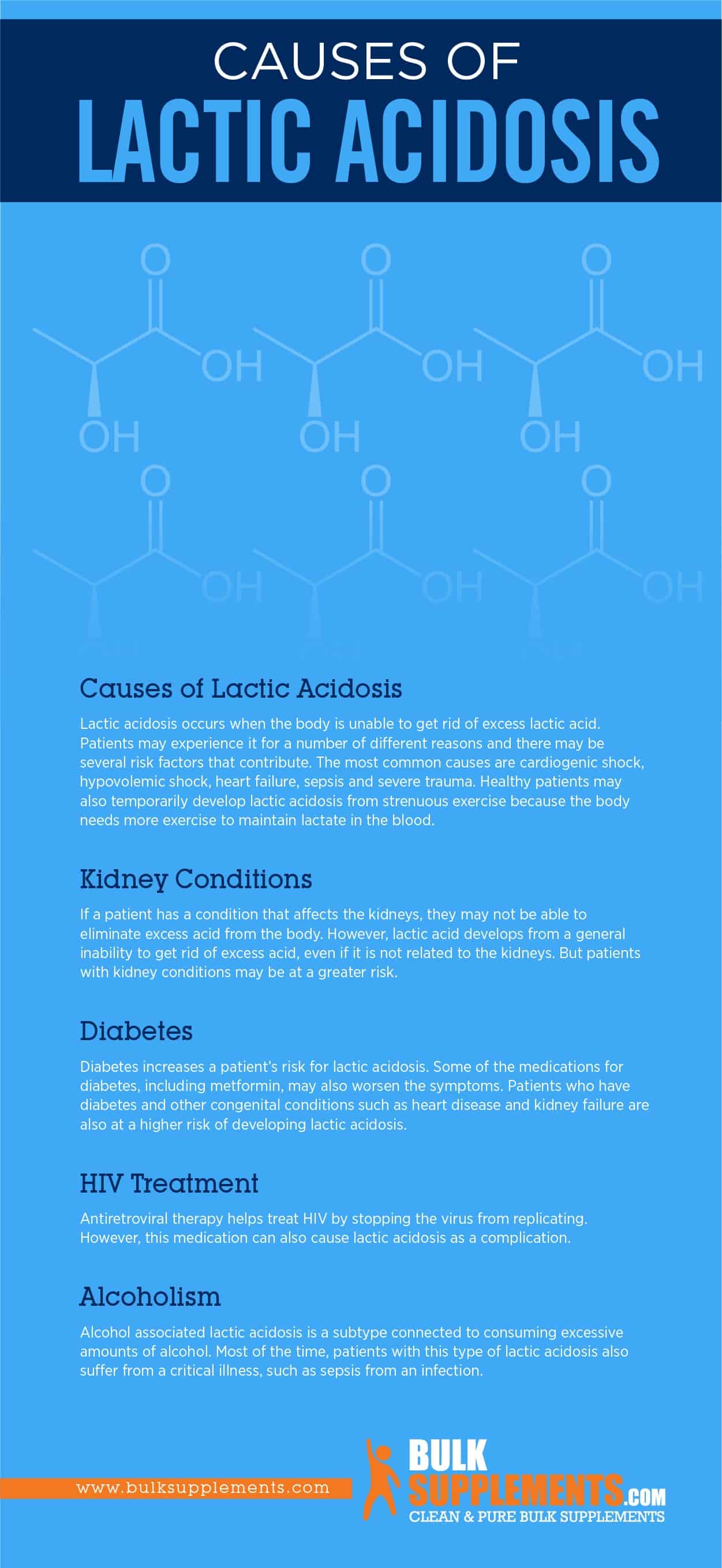Lactic Acidosis: Causes, Symptoms & Treatment

Lactic Acidosis
What is Lactic Acidosis?
Lactic acidosis is a medical condition that develops when the body overproduces lactic acid (or lactate) and cannot adjust to the changes properly. People with this condition often have kidney and liver problems because the organs find it increasingly difficult to eliminate lactic acid from the body. If the body produces more lactic acid than it can remove, acid levels in bodily fluids increase significantly.
Lactic acidosis occurs when there is an inadequate amount of oxygen in the body to break down excess acid in a process called anaerobic metabolism. There are two main types of lactic acid: L-lactate and D-lactate. L-lactate is the leading cause of lactic acidosis.
Types of Lactic Acidosis
There are two main types of lactic acidosis: type A and type B. The most common cause of type A lactic acidosis is tissue hypoxia, in which the patient has an insufficient oxygen supply to body tissues. Patients often develop it from strenuous exercise. Other causes include septic shock and acute medical conditions that affect the liver or the cardiovascular system. Type B lactic acidosis is mainly a result of renal diseases and some types of cancer. Other causes include HIV medications, diabetes, alcoholism and chronic liver diseases.
Symptoms of Lactic Acidosis
Generally, the symptoms of lactic acidosis often signal an underlying medical condition but they may not draw too much attention on their own. In some cases, symptoms may be more general. For example, the patient may feel abdominal pain, loss of appetite and weakness. It may also cause fatigue, sleep disturbances, diarrhea, headaches, nausea and vomiting. However, some symptoms may indicate a medical emergency—jaundice, rapid heart rate, rapid breathing, shortness of breath and disorientation.
Acidosis vs. Acidemia
Some people use the words “acidemia” and “acidosis” interchangeably. Although the two terms refer to abnormally high acidic levels in the body, they have different meanings. Acidemia is a condition that causes extremely low pH levels in the blood. But acidosis is the process that causes it. Acidosis may be a result of various factors, including pneumonia, diabetes and kidney failure. However, acidemia often results from medical conditions with genetic links. Acidemia also has more severe clinical outcomes, potentially affecting cardiovascular function and blood flow.
Causes of Lactic Acidosis
Lactic acidosis occurs when the body is unable to get rid of excess lactic acid. Patients may experience it for a number of different reasons and there may be several risk factors that contribute. The most common causes are cardiogenic shock, hypovolemic shock, heart failure, sepsis and severe trauma. Healthy patients may also temporarily develop lactic acidosis from strenuous exercise because the body needs more exercise to maintain lactate in the blood.
Kidney Conditions
If a patient has a condition that affects the kidneys, they may not be able to eliminate excess acid from the body. However, lactic acid develops from a general inability to get rid of excess acid, even if it is not related to the kidneys. But patients with kidney conditions may be at a greater risk.
Diabetes
Diabetes increases a patient’s risk for lactic acidosis. Some of the medications for diabetes, including metformin, may also worsen the symptoms. Patients who have diabetes and other congenital conditions such as heart disease and kidney failure are also at a higher risk of developing lactic acidosis.
HIV Treatment
Antiretroviral therapy helps treat HIV by stopping the virus from replicating. However, this medication can also cause lactic acidosis as a complication.
Alcoholism
Alcohol associated lactic acidosis is a subtype connected to consuming excessive amounts of alcohol. Most of the time, patients with this type of lactic acidosis also suffer from a critical illness, such as sepsis from an infection.

Diagnosing Lactic Acidosis
The standard diagnostic procedure for lactic acidosis is to measure lactate levels in the blood. Usually the doctor takes the sample from a vein in the arm, but they may also take blood from an artery. When the body has a normal amount of oxygen, carbohydrates break down to water in carbon dioxide, but if oxygen levels are too low, it breaks down into lactic acid.
Treatment for Lactic Acidosis
Treating lactic acidosis depends on the underlying health complication that causes it. For some patients, treatment is simple and the condition is only temporary. But for others, treatment may be more complicated. It may not be easy for doctors to find a root cause but in the meantime, patients usually receive different treatment to support circulation and help them breathe better. For example, they may need intravenous fluids, an oxygen mask, vitamin therapy, hemodialysis or positive pressure ventilation. Patients who experience symptoms of lactic acidosis during exercise should take regular breaks and rest, drinking lots of water.
Preventing Lactic Acidosis
To prevent exercise-induced lactic acidosis, always begin workout routines gradually. It may be dangerous to go from a state of inactivity straight to running. Start with relatively simple exercises and slowly build pace and intensity. This habit will give the body adequate time to build tolerance and increase its lactate threshold.
Drink lots of water to remove excess acid from the body, especially during exercise. Staying hydrated helps eliminate lactic acid, replenish fluids, break down nutrients into energy, prevent muscle cramps and relieve sore muscles.
Stretch and warm up the muscles before and after exercising. Stretching and warming up helps to improve circulation, relieve tension and increase flexibility. During workouts, make sure to take deep breaths to deliver more oxygen to the body and keep lactic acid from building up. Try to incorporate breathing techniques into workouts and throughout the day.
Take some time between workouts to rest to allow your muscles to recover. Resting also makes breathing easier and helps break down excess lactic acid in the body. In addition, eat a balanced diet of lean meats, whole grains, fruits and vegetables.
SEE ALSO

White Tongue: Symptoms, Causes & Treatment
Supplements for Lactic Acidosis
Patients may also find relief from natural dietary supplements. They may effectively break down lactic acid in the body to potentially relieve or prevent lactic acidosis. Supplements can also help boost athletic performance. However, do not take any supplements without consulting a doctor. They do not treat lactic acidosis or any other medical condition, but they may help improve overall health.
Beta-Alanine
Beta-alanine is a natural amino acid the body uses to build proteins. It helps build lean muscles and improve athletic performance. It also helps break down lactic acid during exercise, improving endurance for short, high-intensity workouts. The recommended dosage for beta alanine supplements is 500 mg per day, mixed with water or juice. Overdose may cause a tingling sensation in the hands and face, nausea, lightheadedness and abdominal discomfort. However, a doctor may suggest a higher or lower dosage to achieve the patient’s intended effect.
L-Glutamine Powder
Glutamine is an abundant amino acid to build proteins. Most of the time, the body makes enough of it on its own, but patients with certain medical conditions may need supplements. Glutamine can promote athletic performance and digestive health. Take 500 to 1,000 mg of L-glutamine supplements up to three times per day before a workout on an empty stomach.
Calcium
Calcium promotes healthy bones and teeth. It is the most abundant mineral in the human body, but the body cannot make it on its own so people can only get it from food, water or supplements. The recommended dosage for calcium citrate powder is 4,100 mg per day after meals.
Coenzyme Q10
Coenzyme Q10 is a water-insoluble supplement that promotes immune health and boosts energy production. It also helps support muscles and joints. The recommended dosage for coenzyme Q10 powder is between 50 and 200 mg per day. Physicians may recommend a higher dosage for patients with some health complications.
L-Carnitine
L-carnitine promotes athletic endurance as well as cardiac health. In addition, it contains hydrochloric acid that improves digestion and absorption. Carnitine may also boost exercise performance by stimulating fatty acid oxidation and preventing lactate buildup. The recommended dosage for L-carnitine base powder is 500 mg up to twice a day.
Magnesium
Magnesium has many benefits on the body, including indigestion and relieving heartburn. It is also a mild laxative that can help minimize abdominal discomfort. It contains compounds that can fuel the brain, muscles and the heart, especially in people with low carbohydrate levels. The recommended dosage for magnesium citrate powder is 4,400 mg once a day mixed in liquids.
The Bottom Line
Lactic acidosis occurs when the body produces more lactic acid than it can get rid of. Common causes of this condition include strenuous exercise, HIV medication, diabetes, septic shock, trauma, alcoholism, kidney conditions and liver diseases. Symptoms include nausea, muscle cramps, abdominal pain, lack of appetite, fatigue, diarrhea and headaches. Treatment depends on the underlying cause, but there are supplements that may help. However, they are not a cure for lactic acidosis or any other medical treatment. Instead, supplements aim to improve overall health.



